Overview
The Chkalov Aviation Plant in Novosibirsk is one of the largest aerospace manufacturers in Russia. Cavers working there made ascenders before commercial options became readily available in Russia.
This table shows the main difference between the different versions in my collection. Most if not all of these were made in the 1990s, The natural progression shows why I think this may be the correct chronological order, with uncertainty about the order Versions D & E:
| Version |
Handle |
Frame |
Safety |
Cam Rivet |
| Version A |
Textured Plastic |
Painted |
Stamped |
Round head semitubular |
| Version B |
Textured Plastic |
Painted |
Milled I |
Double-ended semitubular |
| Version C |
Textured Plastic |
Anodized |
Milled II |
Double-ended semitubular |
| Version D |
Smooth Plastic |
Anodized |
Milled II |
Double-ended semitubular |
| Version E |
Phosphorescent |
Anodized |
Milled II |
Double-ended semitubular |
|
[ Top
| Version B
| Version C
| Version D
| Version E
| Return to H.E.C. Ascenders ]
Version A
(#3445)
Technical Details
Artyom Babin (Артём Бабин) sent me this Chkalov Aviation Plant ascender in 2021.
This ascender is 221 mm. tall, 103 mm. wide, 30 mm. thick, and weighs 233 g.
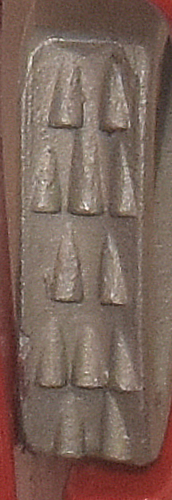 The shell is a tall irregular shaped stamping made from 3.9 mm.
aluminum alloy sheet metal. A 16 mm. diameter rope channel
is formed in the upper portion of one side and a smaller cam channel
lies opposite. A hole drilled through both sides of the cam channel
accepts a 6 mm. semi-tubular rivet. The cam and cam spring are mounted
on this rivet. The rivet is centered 54 mm. from the inside of the rope channel.
The shell is a tall irregular shaped stamping made from 3.9 mm.
aluminum alloy sheet metal. A 16 mm. diameter rope channel
is formed in the upper portion of one side and a smaller cam channel
lies opposite. A hole drilled through both sides of the cam channel
accepts a 6 mm. semi-tubular rivet. The cam and cam spring are mounted
on this rivet. The rivet is centered 54 mm. from the inside of the rope channel.
The handle below the cam has a hard plastic hand
grip molded into place. The hand grip has four finger grooves.
A 16.0 mm. sling attachment hole lies below the handle opening.
Another 16.0 mm. hole provides an attachment point just above the cam. The attachment
holes are well rounded.
The cam is a plated skeletonized steel casting. The cam radius
increases from 46 to 62 mm. over an angle of 37°, giving
a 25° cam angle. The cam has number of small conical teeth,
but these are not pointed - the teeth look like the side view
of a cone. The tooth pattern is (2.3)^2(2). The cam safety is an
aluminum lever mounted on a 3 mm. roll pin in the same shell
channel as the cam. A second spring mounted on this roll pin serves
as a safety spring. Normally this spring holds the safety where
it blocks the cam from opening. When the end of the safety lever
is depressed, the opposite end pivots upwards so that the cam
is no longer obstructed.
The front strap is stamped with "02" and "08" (possibly a date) and "11."
This ascender features a thumb safety similar to that found on the Clog Expedition and the CMI Expedition ascenders, but the frame is more like the Kong-Bonaiti or Petzl Ascension .
The cam teeth hold better than I expected.
This version has small differences in the frame compared to the otherrs. It is the only one that uses a round-head semitubular rivet for the cam axle. It is also the only one that uses a safety made from a twisted 10 mm. x 3.9 mm. metal strip rather than being milled.
[ Top
| Version A
| Version C
| Version D
| Version E
| Return to H.E.C. Ascenders ]
Version B
(#122)
Technical Details
I acquired this Chkalov Aviation Plant ascender from John E. Weinel, Inc.
in 1996.
This version is 223 mm. tall, 102 mm. wide,
30 mm. thick, and weighs 234 g.
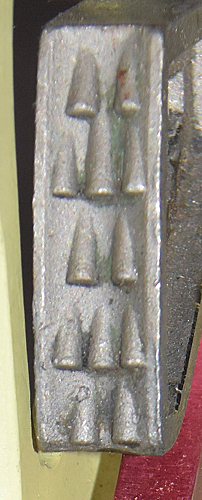 The shell is a tall irregular shaped stamping made from 3.9 mm.
aluminum alloy sheet metal. A 16 mm. diameter rope channel
is formed in the upper portion of one side and a smaller cam channel
lies opposite. A hole drilled through both sides of the cam channel
accepts a 6 mm. semi-tubular rivet. Both ends of the rivet are rolled;
there is no head per se. The cam and cam spring are mounted
on this rivet.
The shell is a tall irregular shaped stamping made from 3.9 mm.
aluminum alloy sheet metal. A 16 mm. diameter rope channel
is formed in the upper portion of one side and a smaller cam channel
lies opposite. A hole drilled through both sides of the cam channel
accepts a 6 mm. semi-tubular rivet. Both ends of the rivet are rolled;
there is no head per se. The cam and cam spring are mounted
on this rivet.
The handle below the cam has a hard plastic hand
grip molded into place. The hand grip has four finger grooves.
A 15.8 mm. sling attachment hole lies below the handle opening.
Another 15.8 mm. hole provides an attachment point just above the cam. The attachment
holes are well rounded.
The cam is a plated skeletonized steel casting. The cam radius
increases from 46 to 62 mm. over an angle of 37°, giving
a 25° cam angle. The cam has number of small conical teeth,
but these are not pointed - the teeth look like the side view
of a cone. The tooth pattern is (2.3)^2(2). The cam safety is a machined
aluminum lever mounted on a 3 mm. roll pin in the same shell
channel as the cam. A second spring mounted on this roll pin serves
as a safety spring. Normally this spring holds the safety where
it blocks the cam from opening. When the end of the safety lever
is depressed, the opposite end pivots upwards so that the cam
is no longer obstructed.
There are no markings on this ascender.
The Chkalov Aviation Plant in Novosibirsk produced the Russian SU-34 fighter bomber. The paint on this ascender matches the paint used to paint that plane’s airframe members.
The visible crack shows that the plastic handle on this ascender is deteriorating with age.
[ Top
| Version A
| Version B
| Version D
| Version E
| Return to H.E.C. Ascenders ]
Version C
(#3520)
Technical Details
Artyom Babin (Артём Бабин) sent me this Chkalov Aviation Plant ascender in 2022.
This version is 220 mm. tall, 101 mm. wide, 29 mm. thick, and weighs 233 g.
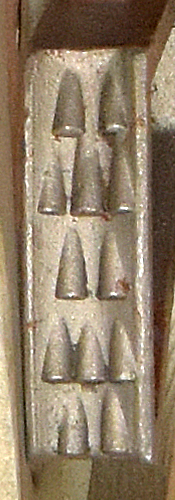 The shell is a tall irregular shaped stamping made from 3.7 mm.
aluminum alloy sheet metal. A 16 mm. diameter rope channel
is formed in the upper portion of one side and a smaller cam channel
lies opposite. A hole drilled through both sides of the cam channel
accepts a 6 mm. semi-tubular rivet. Both ends of the rivet are rolled;
there is no head per se. The cam and cam spring are mounted
on this rivet. The cam axle is centered 55 mm. from the inside of the rope channel.
The shell is a tall irregular shaped stamping made from 3.7 mm.
aluminum alloy sheet metal. A 16 mm. diameter rope channel
is formed in the upper portion of one side and a smaller cam channel
lies opposite. A hole drilled through both sides of the cam channel
accepts a 6 mm. semi-tubular rivet. Both ends of the rivet are rolled;
there is no head per se. The cam and cam spring are mounted
on this rivet. The cam axle is centered 55 mm. from the inside of the rope channel.
The handle below the cam has a hard plastic hand
grip molded into place. The hand grip has four finger grooves.
A 15.6 mm. sling attachment hole lies below the handle opening.
Another 15.6 mm. hole provides an attachment point just above the cam. The attachment
holes are slightly rounded.
The cam is a plated skeletonized steel casting. The cam radius
increases from 46 to 62 mm. over an angle of 37°, giving
a 25° cam angle. The cam has number of small conical teeth,
but these are not pointed - the teeth look like the side view
of a cone. The tooth pattern is (2.3)^2(2). The cam safety is a machined
aluminum lever mounted on a 3 mm. roll pin in the same shell
channel as the cam. A second spring mounted on this roll pin serves
as a safety spring. Normally this spring holds the safety where
it blocks the cam from opening. When the end of the safety lever
is depressed, the opposite end pivots upwards so that the cam
is no longer obstructed.
There are no markings on this ascender.
Although I am not 100% certain, it appears that the frame of this ascender is anodized. I have not ruled out the possibility that this has a plated or a zinc chromate finish.
The safety on this version is milled, but the shape is more refined than the one on the previous version.
A visible crack on the spine and a missing piece on the rear show that the plastic handle on this ascender is deteriorating with age.
The cam is only 11.6 mm. wide, and there are no washers to keep it centered in the rope channel. It tends to slide toward the frame. leaving a 4.6 mm. gap. This can allow the rope to become trapped between the cam and frame if one is not careful. This would be more likely with thinner and softer-lay ropes.
[ Top
| Version A
| Version B
| Version C
| Version E
| Return to H.E.C. Ascenders ]
Version D
(#3486)
Technical Details
Artyom Babin (Артём Бабин) sent me this Chkalov Aviation Plant ascender in 2021.
This version is 221 mm. tall, 99 mm. wide, 29 mm. thick, and weighs 222 g.
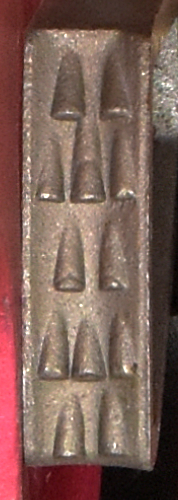 The shell is a tall irregular shaped stamping made from 3.7 mm.
aluminum alloy sheet metal. A 16 mm. diameter rope channel
is formed in the upper portion of one side and a smaller cam channel
lies opposite. A hole drilled through both sides of the cam channel
accepts a 6 mm. semi-tubular rivet. Both ends of the rivet are rolled;
there is no head per se. The cam and cam spring are mounted
on this rivet.
The shell is a tall irregular shaped stamping made from 3.7 mm.
aluminum alloy sheet metal. A 16 mm. diameter rope channel
is formed in the upper portion of one side and a smaller cam channel
lies opposite. A hole drilled through both sides of the cam channel
accepts a 6 mm. semi-tubular rivet. Both ends of the rivet are rolled;
there is no head per se. The cam and cam spring are mounted
on this rivet.
The handle below the cam has a hard plastic hand
grip molded into place. The hand grip has four finger grooves.
A 15.8 mm. sling attachment hole lies below the handle opening.
Another 15.8 mm. hole provides an attachment point just above the cam. The attachment
holes are well rounded.
The cam is a plated skeletonized steel casting. The cam radius
increases from 46 to 62 mm. over an angle of 37°, giving
a 25° cam angle. The cam has number of small conical teeth,
but these are not pointed - the teeth look like the side view
of a cone. The tooth pattern is (2.3)^2(2). The cam safety is a machined
aluminum lever mounted on a 3 mm. roll pin in the same shell
channel as the cam. A second spring mounted on this roll pin serves
as a safety spring. Normally this spring holds the safety where
it blocks the cam from opening. When the end of the safety lever
is depressed, the opposite end pivots upwards so that the cam
is no longer obstructed.
There are no markings on this ascender.
The cam is only 11.6 mm. wide, and there are no washers to keep it centered in the rope channel. It tends to slide toward the frame. leaving a 4.4 mm. gap. This can allow the rope to become trapped between the cam and frame if one is not careful. This would be more likely with thinner and softer-lay ropes.
The plastic used in the handle is different than that used in the other versions. Like those, it is cracking, showing that it is deteriorating with age.
[ Top
| Version A
| Version B
| Version C
| Version D
| Return to H.E.C. Ascenders ]
Version E
(#3635)
Technical Details
I acquired this ascender from Artyom Babin (Артём Бабин) in 2024.
This version is 221 mm. tall, 99 mm. wide, 25 mm. thick, and weighs 223 g.
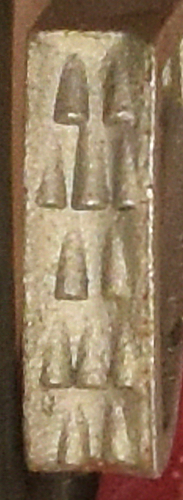 The shell is a tall irregular shaped stamping made from 3.7 mm.
aluminum alloy sheet metal. A 16 mm. diameter rope channel
is formed in the upper portion of one side and a smaller cam channel
lies opposite. A hole drilled through both sides of the cam channel
accepts a 6 mm. semi-tubular rivet. Both ends of the rivet are rolled;
there is no head per se. The cam and cam spring are mounted
on this rivet.
The shell is a tall irregular shaped stamping made from 3.7 mm.
aluminum alloy sheet metal. A 16 mm. diameter rope channel
is formed in the upper portion of one side and a smaller cam channel
lies opposite. A hole drilled through both sides of the cam channel
accepts a 6 mm. semi-tubular rivet. Both ends of the rivet are rolled;
there is no head per se. The cam and cam spring are mounted
on this rivet.
The handle below the cam has a hard plastic hand
grip molded into place. The hand grip has four finger grooves.
A 15.8 mm. sling attachment hole lies below the handle opening.
Another 15.8 mm. hole provides an attachment point just above the cam. The attachment
holes are well rounded.
The cam is a plated skeletonized steel casting. The cam radius
increases from 46 to 62 mm. over an angle of 37°, giving
a 25° cam angle. The cam has number of small conical teeth,
but these are not pointed - the teeth look like the side view
of a cone. The tooth pattern is (2.3)^2(2). The cam safety is a machined
aluminum lever mounted on a 3 mm. roll pin in the same shell
channel as the cam. A second spring mounted on this roll pin serves
as a safety spring. Normally this spring holds the safety where
it blocks the cam from opening. When the end of the safety lever
is depressed, the opposite end pivots upwards so that the cam
is no longer obstructed.
There are no markings on this ascender.
This version has a phosphorescent plastic handle. Like the others, it is cracking, showing that it is deteriorating with age.
[ Top
| Version A
| Version B
| Version C
| Version D
| Version E
]


